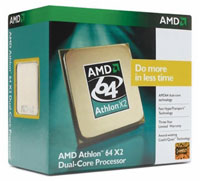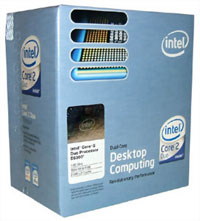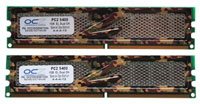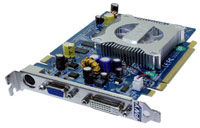Basic Midrange Configurations
We'll start with the Intel and AMD options for what we consider a basic midrange computer. These will offer good performance for a variety of tasks, but they are not tailored towards anything in particular. Before we get into the actual component lists, let's take a moment to clarify a few things. First, a lot of people certainly don't need all of the options we are listing below. Dual core processors are faster for some tasks, but there are still plenty of applications that run perfectly well on older systems, and they certainly don't need the processing power offered by a dual core CPU. Not everyone needs 2GB of memory, a discrete graphics card, a relatively large hard drive, etc. However, we are building what we consider to be a good all-around computer, and individualization can still be beneficial. If you're looking to cut costs a bit further, you can find additional information and advice in our last
Entry Level Buyer's Guide.
A second topic that we need to address is the question of AMD Athlon X2 versus Intel Core 2 Duo processors. If performance is your primary consideration, there are very few areas where Core 2 Duo isn't faster. Once you reach the Core 2 Duo E6600, it becomes faster than just about any official AMD Athlon X2 processor in overall performance, and the only way you will surpass its performance is with overclocking. When you start overclocking both platforms, however, Core 2 Duo is basically out of reach of AMD's current processor line. So Core 2 Duo is the way to go, right?
In actuality, AMD has done what most companies do when their product does not offer best in class performance: they cut prices, sometimes quite drastically. Motherboards for AMD systems also tend to be a bit less expensive than their Intel counterparts. The net result is that while Intel is undoubtedly the faster processor overall, AMD is very competitive - and perhaps even better - when it comes to price/performance. That goes double if you plan on getting a single core processor, as Intel doesn't offer any compelling single core solutions right now. We're sticking with dual core processors for our midrange and higher recommendations, but whichever way you choose to go the bottom line is that you can get a lot of performance without spending a ton of money, so try to spend your money where it will offer the most benefit.
| AMD Mid-Range Base System |
| Hardware |
Component |
Price |
Rebates |
| Processor |
Athlon 64 X2 3800+ AM2 (2x512K 2.0GHz) - Retail |
$133 |
|
| Motherboard |
DFI Infinity NF ULTRAII-M2 |
$95 |
|
| Memory |
OCZ S.O.E 2x1GB DDR2-667 (OCZ2SOE6672GK) |
$221 |
$30 |
| Video Card |
PNY GeForce 7600GS 256MB (VCG7600SXPB) |
$96 |
|
| Hard Drive |
Seagate 320GB SATA 3.0Gbps 7200RPM 16MB (Barracuda 7200.10) |
$90 |
|
| Optical Drive |
LG Black 18X DVD+R (GSAH22N-BK) |
$36 |
|
| Case |
Cooler Master Centurion 534 (RC-534-KKN2-GP) |
$66 |
$10 |
| Power Supply |
FSP Group (Fortron Source) 450W (AX450-PN) |
$62 |
|
| Display |
Acer AL2016W 20" 8ms (1680x1050) |
$233 |
|
| Speakers |
Logitech X-530 5.1 70W Speakers |
$74 |
|
| Keyboard and Mouse |
Microsoft Comfort Curve 2000 B2L-00047 |
$28 |
|
| Operating System |
Windows XP MCE 2005 (with Vista coupon) |
$115 |
|
| Bottom Line |
|
$1249 |
$1209 |
| Intel Mid-Range Base System |
| Hardware |
Component |
Price |
Rebates |
| Processor |
Intel Core 2 Duo E6300 (1.86GHz 2MB Shared) - Retail |
$185 |
|
| Motherboard |
Biostar TForce965PT (P965 775) |
$111 |
|
| Memory |
OCZ S.O.E 2x1GB DDR2-667 (OCZ2SOE6672GK) |
$221 |
$30 |
| Video Card |
PNY GeForce 7600GS 256MB (VCG7600SXPB) |
$96 |
|
| Hard Drive |
Seagate 320GB SATA 3.0Gbps 7200RPM 16MB (Barracuda 7200.10) |
$90 |
|
| Optical Drive |
LG Black 18X DVD+R (GSAH22N-BK) |
$36 |
|
| Case |
Cooler Master Centurion 534 (RC-534-KKN2-GP) |
$66 |
$10 |
| Power Supply |
FSP Group (Fortron Source) 450W (AX450-PN) |
$62 |
|
| Display |
Acer AL2016W 20" 8ms (1680x1050) |
$233 |
|
| Speakers |
Logitech X-530 5.1 70W Speakers |
$74 |
|
| Keyboard and Mouse |
Microsoft Comfort Curve 2000 B2L-00047 |
$28 |
|
| Operating System |
Windows XP MCE 2005 (with Vista coupon) |
$115 |
|
| Bottom Line |
|
$1317 |
$1277 |
 |
 |
For your typical midrange computer, we've gone with a selection of high-quality parts that offer a great price/performance ratio. With either of the above systems, you should easily be able to run all current applications, along with Windows Vista, with one possible exception: games. You can even run all current games, just not at maximum detail settings or high resolutions. The performance edge goes to the Intel E6300 build, but obviously the performance advantage comes with a pricing disadvantage. If you want to spend the same amount of money on both platforms, you could actually put an Athlon X2 4600+ into the AMD system and end up with typically better performance than the E6300. If you don't plan on stressing the CPU a lot, however, even an X2 3800+ on is more than sufficient. If you need more information about the various processors available, you may find it helpful to refer to our
Holiday CPU Guide.
The motherboard selections were chosen with an eye towards stability and cost without sacrificing performance. The AM2 motherboard actually uses the older NVIDIA nForce4 chipset, but we have found the performance and stability offered to be beyond reproach in the DFI motherboard. Likewise, the Biostar TForce 965PT is one of the most compelling P965 solutions currently available, offering good performance, stability, and features. Overclocking is also an option on either of these motherboards, and while they may not be the absolute best overclocking options around, they should be more than sufficient for the majority of users. Strictly in terms of features, the edge belongs to the DFI board, as it includes FireWire support. It is possible to get FireWire for socket 775 but it will usually require spending a bit more money than the Biostar board.
 |
Finding good DDR2 memory without spending a lot of money is still difficult, although prices have dropped quite a bit in the past several months. There are a few DDR2-800 offerings available that only cost a bit more money than DDR2-667, but with 5-5-5 timings instead and once you factor in mail-in rebates we feel that the OCZ S.O.E. (that's "Special Ops Edition" if you were wondering) DDR2-667 is probably the best option right now. It runs at 4-4-4 timings with 1.9V and shouldn't have any problem posting at 1.8V, and with a bit higher voltage you should be able to overclock to at least DDR2-800 (if you want to). We wouldn't go beyond about 2.1V for this memory, as that tends to be the safe limit for anything that doesn't use Micron D memory chips.
 |
The choice of graphics card is one of the more difficult decisions, but what is best is going to vary greatly by individual. The GeForce 7600 GS is a good entry level GPU, providing the features and performance necessary to accomplish most tasks. AMD's Radeon X1650 Pro offers a similar level of performance at a slightly higher price. Either one should work well, but if you need more options for graphics cards, check out our recent
Holiday GPU Guide.
Choosing among the different storage components these days usually ends up coming down to price as the deciding factor, as the performance offered is very close between the various brands. For the hard drives, we also factored in price per GB, and ended up with 320GB models being the best overall choices. Seagate and Western Digital are the least expensive brands and they both offer good performance and features, with Hitachi, Samsung, and Maxtor (who is now owned by Seagate) being the other major brands. The Western Digital 320GB Caviar SE16 and Seagate Barracuda 7200.10 320GB both cost around $90 and it's basically a tossup determining which is better. Both brands trade punches in benchmarks, coming in faster in some tests and slower in others; Seagate seems to do better in multimedia applications while Western Digital does better in multitasking scenarios, but in day-to-day use most people likely wouldn't be able to tell the difference.
















43 Comments
View All Comments
JarredWalton - Sunday, January 21, 2007 - link
Some of the PCs are kept up to date for gaming parties and the like. Others are just mostly sitting around waiting for me to test something on an older platform or whatever. Others are basically spare parts. In the winter, I turn on a lot of them to provide heat - I only have electric heaters anyway, so whether I'm putting the electricity into the heaters or into PCs doesn't make much difference to me. I run Folding@Home in such cases to increase heat output, and if the house starts getting too warm I shut down systems. :)chrnochime - Friday, January 19, 2007 - link
Basic Config - AccessoriesBoth times that Fortron appeared, it was written as "Fotron". FSP would probably appreciate that you spell their name correctly....
JarredWalton - Friday, January 19, 2007 - link
Awesome! I've been misspelling their name for years and this is the first time anyone has corrected me. Oops! Thanks -- I will see to it that they don't make that mistake again. :-)JarredWalton - Friday, January 19, 2007 - link
Speech recognition. "they" = "I"noxipoo - Friday, January 19, 2007 - link
should be around $1500.screech - Friday, January 19, 2007 - link
basic midrange page:" With either of the above systems, you should easily be able to run all current applications, along with Windows Vista, with one possible exception: games. You can even run all current games,"
Perhaps a little rewording is in order? ;)
JarredWalton - Friday, January 19, 2007 - link
Not sure what you mean - maybe I'm just blind. Basically, you can run all current games, but not at maximum detail, hence it's a "possible exception".dqniel - Friday, January 19, 2007 - link
Rosewill PSUs? Absolutely awful. OCZ S.O.E. ram? Horrible track record with C2D chipsets and a poor price to performance ratio. G.Skill "HK" series RAM for the OCing system? 2x1GB kits using Micron D9 are available for the same price. A $267 Super Talent kit on Newegg for example. Asus P5B-E 1.02 motherboard? Not even available in the U.S. OCZ GameXStream PSU? Such horrible voltage ripple problems that I wouldn't trust it in a budget rig. The Corsair 520w or Zalman 600w would be much better choices.I'm confused as to how this thing got past quality control and was published.
JarredWalton - Friday, January 19, 2007 - link
Several editors felt the G.Skill RAM was a good choice, but the Super Talent is arguably just as good if not better. Considering the G.Skill is now out of stock, I'll switch the RAM to the Super Talent - which is not Micron D9 memory as far as I'm aware, but still uses Micron chips and performs quite well (unless you're looking at some other ST memory?). The OCZ S.O.E. mostly suffered from early P965 BIOS issues, and with the rebate it comes in as very good RAM for a relatively low price. If you don't like rebates, we would suggest other DDR2-800 RAM price at around $200, which will perform about the same (within 2% most likely). As for the rest...There are about five different 700W PSUs available that are all based off the 700W Fotron Source. OCZ GameXStream is the cheapest at present, and despite your concerns with the "horrible voltage ripple" we have found the PSU to work extremely well in various systems. The overall experience most people have had with this PSU is very good - no product is perfect, and there will always be a few bad units out there - and for the price it's difficult to say that any PSU is universally better. You can get quieter PSUs (with lower wattage ratings - although those are mostly hype), and the Corsair 520W you mention is a good PSU. Is it better, though? That's difficult to say.
The Rosewill PSU is in a different boat. Every time anyone recommends a PSU from some lesser brand, criticisms are sure to come. Rosewill PSUs in our experience are decent, and while Deer Electronics or Solytech or whoever may be the OEM, companies can and do get better. I've got one of the Rosewill 600W PSUs running a system and I've had no complaints with it. I haven't tried to overload the PSU to make it fail, but it appears to be about as good as several other ~550W PSUs I have (in terms of efficiency) and it's quite a bit cheaper. It's also a bit more noisy, but when you've got CrossFire X1900 GPUs most other fans are quiet by comparison. When it can run a CrossFire setup without any issues, that's pretty good for a $75 PSU. Of course, I'm not a PSU reviewer, but http://www.jonnyguru.com/review_details.php?id=48">JohnnyGuru took a look at a 500W Rosewill so maybe you'll trust his results? Not bad for a budget PSU, and it's probably safe to say the 600W listed in this BG is of similar quality to their 500W unit.
Finally, for the motherboard I've listed the DS3 and the P5B-E, on the recommendation of Gary as he tends to do most of our motherboard reviews and he's tried all of the boards. My understanding was that the 1.02G is available in the US, but perhaps you're right. The P5B-E still offers a few features other boards lack at that price point, so depending on whether you prefer better OC'ing (DS3) or features will determine which board is right for you.
If singling out 5 components out of 31 that you dislike turns an article into a horrible mess that's not worthy of publication, I'm sorry to disappoint. I can't say for certain that every one of these components is best in class and will work with every possible system configuration out there (i.e. motherboards can be picky about RAM at times), but I can say that the configurations listed will work very well according to our testing of the various parts. Most of the criticisms you've brought up will hardly make a difference on the final result.
dqniel - Friday, January 19, 2007 - link
Let me first state that perhaps I exaggerated a bit. I didn't mean to imply that the guide was "a horrible mess." Simply put, I think the guide is below Anandtech's standards in terms of having nearly perfect product selection in the given price range. Why settle for "...will hardly make a difference on the final result" when you can squeeze out that extra little bit of performance and stability for your money?I'm sticking by my Super Talent remark in that it has D9GMH chips: http://www.newegg.com/Product/Product.asp?Item=N82...">http://www.newegg.com/Product/Product.asp?Item=N82... (this particular model)
Secondly, I'm glad that you could inform me that most of the S.O.E. problems have been fixed by BIOS updates. I'm sure either the S.O.E. or similarly priced Adata would be perfect choices for the rigs.
As far as the PSUs are concerned- as I'm sure you know, most PSU companies will use varying OEM manufacturers from model to model. The particular Rosewill PSU you chosen, because of the poor choice of OEM manufacturer, for the 600w unit is well below the standards of other budget PSUs such as the Enhance GH models available at the reputable www.ewiz.com. Secondly, there is no reason to get a 700w PSU for the system you suggested even with heavy overclocking thrown into the mix. Power consumption is blown out of proportion and quality is greater than quantity since most companies' units don't actually meet their specified outputs. Because of this, a $120 Corsair HX or $120 Zalman 600w would be a better choice. Adequate power with better quality in terms of ripple while costing less seems like a logical choice. Sure, ripple won't cause any performance problems in the short term, but Jonnyguru and others have stated that in the long run it leads to the death of sensitive components such as RAM. The FSP Epsilon-based units are some of the worst available (with the exception of the Zalman unit) in terms of putting out dangerous ripple.
The P5B-E 1.02 was renamed after the article you guys published. It was released overseas as the P5B-E Plus and is impossible to find in the states without paying ludicrous amounts. The Gigabyte DS3 and P5B-E Deluxe are both fantastic and widely available, however.